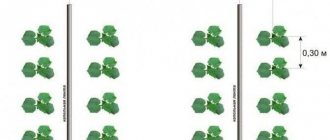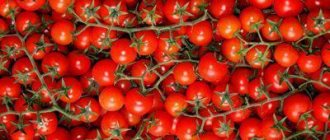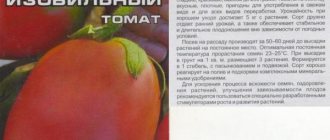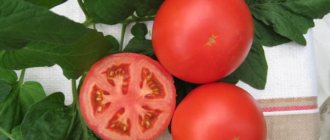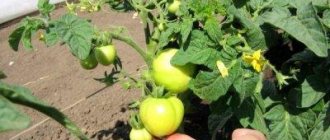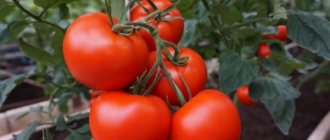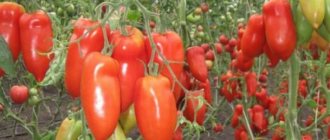Description of Shasta F1 tomatoes
The tomato belongs to the determinate type, i.e., having limited growth. The maximum height of the plant is no more than 80 cm. Shasta F1 is an extremely early hybrid. The period between emergence and fruit ripening is about 90 days. The bush is powerful, has many brushes with ovaries. Requires support due to high yield.
The stem of the plant is erect, branching. The leaves are dissected, large, bright green. The inflorescences are simple, the stalk has an articulation. The flowers are small, yellow, collected in racemes. They contain both male and female organs. The root system is highly developed, tap-type, goes deep into the ground and spreads over the surface of the soil. The Shasta F1 variety is recommended for industrial use due to its early ripening and sowing in the ground. According to reviews from gardeners, it is possible to form a bush as indeterminate, to save greenhouse space. Agricultural technology allows you to get a large and early harvest of tomatoes.
Growing
Growing fruits can be done in two ways:
- without seedlings;
- using seedlings.
The first method is different in that the seeds are immediately sown in the beds; suitable weather conditions are required: the air temperature during the day is not lower than +20°...+23 °C, and at night - not lower than +16 °C. Seeds need to be sown, taking into account the future growth of the bush. It is recommended to make the distance between the holes 40-50 cm.
The beds should be covered with film until germination begins. It is important to periodically ventilate the beds. In order for the plant to develop well and the bush to be strong, farmers recommend sowing the seeds in soil pre-fertilized with organic matter.
Read also: Cucumber Libelle F1: reviews and characteristics
This method of cultivation is more suitable for the warm southern regions, and for colder regions, cultivation must begin by obtaining seedlings that grow at home up to a certain point.
The second method, harvesting using seedlings, requires a little more time and attention to the plant. To obtain seedlings, seeds are sown in small containers filled with a universal substrate or a mixture of peat and sand (1:1 ratio).
Shasta tomato seeds are sold already processed, so they do not require pre-soaking before sowing.
In order for sprouts to appear, the room with seedlings must have an optimal temperature (+23 ° C) and good lighting. It is recommended to fertilize and harden the sprouts. Hardening should begin when the bush has 2-3 pairs of leaves.
Planting in open ground is carried out when stable warm weather has established. The plant is planted to a depth of 1.5-2 cm, keeping a distance between bushes of 40-50 cm. During the growing process, tomatoes must be cared for: watered, weeded, fertilized and, if necessary, treated with fungicides.
This type of tomato tolerates heat well, but requires regular watering. Due to the high yield, the bushes need to be tied up.
Taste qualities of fruits
Shasta F1 tomatoes are round in shape and bright red in color. The taste is excellent, when ripe it is sweet and sour. Brix (the amount of dry matter in fruits) is 6.5 - 7, the density is high. The skin of the fruit is durable. The weight of tomatoes in a ripe state is 65 - 70 g.
Shasta F1 hybrid for universal use. Suitable for fresh consumption, for processing into juice and puree, and also ideal for canning as a whole, since the skin does not burst under the influence of temperatures. The transportability of the hybrid is high.
Growing tomatoes is one of the agrotechnical techniques
Traditionally, with the appearance of the first flower cluster on the tomato trunks, stepsons begin to grow. They take away all the nutrients that could go to the developing vegetables. Therefore, the agrotechnical technique called pinching is one of the important ones when growing tomatoes. Some gardeners leave a powerful shoot that appears under the brush, allow another brush to develop there, and then pinch it off at the level of two leaves after it. But you shouldn't experiment like that. As the plant grows, all stepsons should be broken out. It is best to perform this procedure once a week. With the arrival of August in its second half, the following manipulations should be performed:
- It is necessary to pinch the tops of the plants.
- Remove any flowers that have formed.
- Remove the formed fruits, the size of which does not exceed the size of a hazelnut.
If the summer turned out to be hot and autumn promises to be the same, then several tomato bushes can be left without pinching.
Pros and cons of the Shasta F1 tomato variety
The advantages of tomato include:
- early maturity of the variety (about 90 days);
- high productivity;
- mass maturation;
- excellent taste;
- versatility of fruit use;
- good keeping quality and transportability;
- low susceptibility to major diseases;
- heat resistance;
- no need for stepsoning;
- low maintenance requirements;
- possibility of growing without seedlings;
- profitability of production when using the Shasta F1 variety.
There are not many disadvantages to tomatoes;
- impossibility of collecting seeds (since the hybrid does not transfer its properties);
- blackleg lesion;
- low drought resistance.
Formation of tomato bushes
This agrotechnical technique for growing tomatoes is the basis. If you do not form a bush at the very beginning, the harvest will not please you with its abundance. When forming, the category of this nightshade crop should be taken into account. There are three of them in total:
- Determinant
- Semi-determinant.
- Indeterminate.
Read also: Varieties of green beans: reviews, descriptions, photos
In order to find out which category a particular variety belongs to, just read the additional information on the back of the package. So, having learned the category, you can safely begin to form plants. Each of them has their own path and their own techniques.
Determinate tomato varieties are low-growing bushes. Agricultural technology for growing tomatoes in this category will require the formation of several stems on the plant. The reason for this is the topping of the plant after a certain number of tassels have formed. To do this, you need to save several stepsons under and above the first flower brush. All others are deleted. At the same time, do not forget that it is necessary to leave the strongest shoots.
Semi-determinate tomato varieties are formed in a similar way. But the agricultural technology of indeterminate tomato varieties requires growing plants in one stem. For this purpose, it is necessary to remove all the formed stepsons on the stem. As a rule, by the third month of summer, about 4-6 tomato clusters appear on the crop.
Agricultural technology of Shasta F1 tomatoes
In 2021, the Shasta F1 variety was included in the State Register of the Russian Federation with a recommendation for cultivation in open ground in the North Caucasus and the Lower Volga region.
Tomatoes on an industrial scale are sown directly into the ground. For this purpose, holes are made in the beds at a distance of 50 cm, into which several seeds are dropped. They are covered with film until shoots emerge.
The dates are determined by day and night temperatures. As soon as it reaches 22 oC during the day and 16 oC at night, tomatoes can be sown.
When preparing the soil, fertilizers are added to the soil.
When sowing seeds, you can be on the safe side by lowering into the holes, in addition to dry seeds, several germinated ones. During return frosts, the seedlings that germinate first may die; dry seeds will sprout later and avoid frost.
As soon as two true leaves appear, the tomatoes must be thinned out for the first time, leaving the strongest plants at a distance of 10 cm from each other. The second time, thinning is carried out in the phase of appearance of the fifth leaf, increasing the distance to 15 cm.
Excess tomatoes should be dug up and replaced with the weakest ones. The transplantation is completed by watering with a solution of a root formation stimulator.
Growing seedlings
Despite recommendations for growing Shasta F1 tomato by sowing directly into the ground, it can also be grown using seedlings. For this purpose, it is necessary to perform a number of operations:
- sort out low-quality seeds by dipping them in a saline solution;
- disinfect in slightly diluted potassium permanganate;
- treat with a growth stimulator;
- harden in the refrigerator by placing the seeds on the bottom shelf;
- saturate with oxygen using bubbling.
To sow a Shasta F1 tomato, you need a soil mixture of peat, sawdust and greenhouse soil. The components are mixed in a ratio of 1:1:2, disinfected by calcination or using a solution of potassium permanganate. The prepared mixture is poured into disinfected containers, pots or boxes. Seeds are placed on the soil, sprinkled a little and covered with film. After this, the containers are transferred to a warm place. As soon as the shoots appear, the film is removed.
In the phase of three true leaves, picking is carried out, and after three weeks it is repeated. At the same time, the seedlings are regularly watered, preventing the soil from drying out.
Landing rules
Shasta F1 tomatoes are planted in open ground under temporary shelter when stable warm weather sets in. It is removed when the threat of return frosts has passed. At the same time, you can plant seedlings in greenhouses.
The holes are made in a checkerboard pattern at a distance of 40 cm from each other.
Each plant is moistened abundantly before planting and, without damaging the roots, removed from the pot. Having placed it in the hole, sprinkle it with soil and water it with warm, settled water.
Watering and fertilizing
Watering and regular fertilizing contribute to a good harvest. Moisturizing is carried out at least twice a week. Young tomatoes of the Shasta F1 variety require 2 liters of water, adults – at least 5 liters. The best time to water is early morning or evening.
Fertilizing is carried out at least three times per season: the first time with nitrogen fertilizers, the second with phosphorus-potassium fertilizers, and the third with microfertilizers.
Fertilizing can be done with organic matter used as mulch.
Pinching and tying
When growing Shasta F1 tomato in open ground on a personal plot or on an industrial scale outside greenhouses, there is no need for pinching. The bush forms itself, remaining low and stocky.
A tomato needs a strong support that allows it to hold the ripening fruits suspended. About 90% of the crop ripens at the same time. After all the tomatoes are ripe, the bushes can be removed.
Formation
According to reviews from experienced gardeners, the Shasta F1 tomato bush can be formed as an indeterminate one, thereby increasing the growth of the plant and its yield. For this purpose, one of the stepsons emerging from the leaf axil is allowed to grow. As soon as it ends with a flower brush, the stepson located above is chosen for further growth. It is important not to remove it so as not to stop the growth of the tomato.
Protection from diseases and pests
Tomato Shasta F1 is quite resistant to late blight and brown spot. If agricultural practices are not followed and climatic conditions are unfavorable, diseases cannot be ruled out. In this case, treatment with drugs that strengthen the immune system, a solution of copper sulfate, is necessary.
Blackleg affects both small seedlings and adult plants. Bordeaux mixture is used to combat it.
The preparations “Grom” and “Phosbecid” help destroy whiteflies and mole crickets.
Planting, growing and caring for plants
Due to the low growth and early ripening of fruits, tomatoes are planted with seeds in the main place without first producing seedlings.
The seeds are planted at a distance of 50 centimeters from each other, several in one hole, and the beds are covered with film until germination. The first planting differs in different regions, but the air temperature during the day should remain between 20–24 degrees, and at night from 16 and above.
To obtain high-quality fruits, the soil is fed with organic fertilizers before sowing. Water as needed during dry summers. If there are a large number of tomatoes on the bush, the plant should be tied up. When there is a gust of wind, the stem will break under the weight. The density of the fruit shell and smooth ripening allow plantations to be harvested mechanically. The hybrid does not require pinching or pruning leaves, so the description of plant care is kept to a minimum:
- weeding;
- fertilizer;
- loosening the soil;
- fungicide treatment.
What to do if plants are infected with fungus? Immediately remove affected areas and treat remaining bushes with chemicals. This will stop the growth of fungi in the garden bed and save the tomato plantation.
The following fungicides are suitable for treatment, reviews of which are positive:
Read also: Siberian hogweed
Before using chemicals, you need to determine the type of disease and use the appropriate drug for this disease. Tomato beds must be disinfected strictly according to the instructions.
A slight deviation in the dosage of the drug in one direction or another can be destructive or ineffective for plants.
A prerequisite for treatment with drugs is safety measures. Manipulations must be carried out in a protective suit, mask, gloves and headgear. After finishing, wash your hands, face and body with soap. Wash all items with powder.
With proper cultivation, the variety will delight its owner with a friendly and high-quality tomato harvest.
Features of the variety
The Shasta f1 hybrid was obtained in order to obtain high yields of early-ripening tomatoes on an industrial scale. It is worth noting that at the moment this variety is the earliest in the world, since only 90 days pass from sowing the seeds in the ground to the full ripening of the fruit. No tomato variety can boast of such indicators.
Our compatriots liked this hybrid because it is suitable for growing in an ordinary garden bed, in small farms and on large areas. Moreover, harvesting can be done not only manually, but also using mechanical means.
tomato Shakira F1 - description and characteristics of the variety
Diseases and pests
The main advantage of Shasta tomatoes is their high resistance to various traditional nightshade diseases. In particular, to the following types:
- verticillium wilt;
- mosaic tomato;
- root rot;
- fusarium;
- cladosporiosis;
- root-knot nematodes;
- top rot.
It is worth noting that the most dangerous disease is blackleg, which can affect both young and adult plants. If such a disease is detected, experts recommend destroying the infected bush and treating the entire plantation with fungicides.
During cultivation periods, the Shasta tomato variety is quite often exposed to various pests, the most important of which include:
- greenhouse whitefly;
- Colorado potato beetle;
- naked slug;
- spider mite.
To get rid of each of these pests, you should use different methods. For example, to get rid of Colorado potato beetles, you must first collect them with your hands and then burn them. As for greenhouse whiteflies, in such cases, the best solution would be to treat the bushes with insecticides. To get rid of aphids and spider mites, you need to use soap solutions.
As preventive methods, and to prevent the appearance of various pests, it is recommended to regularly weed, as well as mulch and loosen the soil.
For a detailed study and familiarization with Shasta tomatoes, you should view the photographs below.
The use of Shasta tomatoes allows gardeners to benefit in any situation, since this variety of tomatoes is distinguished by its high yields, early ripening and transportability, and do not forget about the possibility of mechanical harvesting.
Tomato Shasta F1 is one of the earliest hybrids. Its originator is Innova Seeds Co. American breeders recommend the tomato for commercial use by sowing directly into the ground.
Seedless method
How to properly grow tomatoes in open ground if the seeds are planted immediately? If you have chosen to plant tomatoes in open ground with seeds, you need to select ones that can take root in natural conditions. For planting tomatoes in open ground with seeds, early-ripening varieties are better suited. Tomato varieties for open ground, time-tested by agronomists, take root well with seeds.
- Volgograd tomatoes boast good disease resistance and resistance to temperature fluctuations. The fruits begin to ripen at the same time. The average weight of tomatoes is 110 g.
- It is better to plant seeds of the Iceberg variety in open ground. It continues to develop even in cool weather. The stem is strong and small, only 60 cm. Sweet tomatoes can weigh 200 g.
- Beta-Lux is an early-ripening, high-yielding species. The height of the bush is about 47 cm. The fruits ripen on clusters of 5 pieces, weighing about 50 g. The plant is resistant to cold and major diseases.
- From seeds in open ground, the Dubok variety gives good results. It will allow you to harvest the crop within 85 days after sowing the seeds. The height of the stem is about 50 cm. It shows resistance to many diseases, is unpretentious to the composition of the soil, and tolerates cold. The fruits begin to ripen together and weigh about 70 g.
When to plant tomatoes in open ground if you plan to grow them without seedlings? Sowing seeds in prepared soil begins when the ground warms up, this is approximately mid-April. Make wide beds and add humus. Arcs are installed along the beds, over which the film will then need to be stretched in case of frost.
When planting tomato seeds in open ground, you should leave enough space between the rows. It should be 48 cm. The tomato planting scheme involves digging shallow holes (about 5 cm) in the furrows, reminiscent of a checkerboard arrangement. It is recommended to leave an interval of 28 cm between the recesses.
How to plant tomatoes correctly has its own secrets. Some experienced vegetable growers soak some of the prepared tomato seeds in a nutrient medium. The other part of the seeds should remain dry. Wet seeds germinate better, provided that it is warm outside. If there are frosts, they may die, then dry seeds, which are less sensitive to low temperatures, come to the rescue.
There is another important point about how to plant tomatoes correctly. As soon as the first leaves of the emerging sprouts unfurl, thinning is carried out. Only mature plants should be left at a distance of 9 cm. The second thinning is done when the fifth leaf unfolds. The distance should now be increased to 14.5 cm.
Young sprouts need to be watered less than tomato seedlings in the room. The root system itself develops in such a way as to provide itself with nutrition and moisture. Watering is only necessary during long, hot weather.
Numerous reviews from experienced vegetable growers indicate that even when planting tomatoes with seeds, you can reap a rich and tasty harvest: “This is not the first year we have been sowing directly into garden beds. There is no need to waste energy on growing seedlings, all parts of the sprout are well lit, the root system goes deep and to the sides, there is no need to dive and stress the plant.”
Benefits of the Shasta Hybrid
All of the above characteristics make this variety promising for cultivation in various conditions. Key advantages also include the following qualities:
- friendly and early ripening of tomatoes;
- excellent product characteristics;
- unlimited transportation options;
- ripe fruits with identical parameters;
- resistance to fuarium and other plant pathologies;
- the ability to grow vegetables in large areas.
tomato Miracle bunch F1 - description and characteristics of the variety
